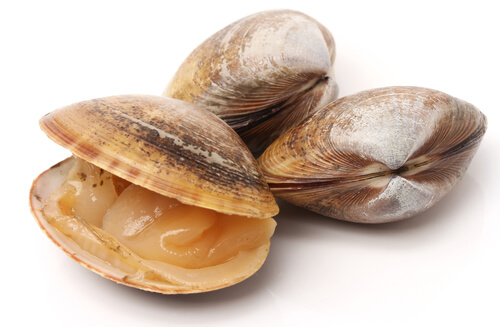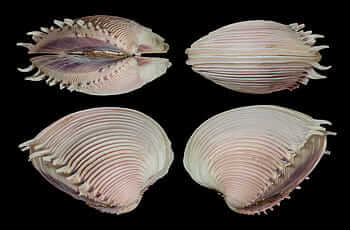9 Curiosities About Clams


Written and verified by the biologist Cesar Paul Gonzalez Gonzalez
Clams are famous for their usefulness in the preparation of several succulent dishes. However, the specimens used in gastronomy aren’t the only ones that exist. Clams belong to one of the animal groups with the greatest biological diversity. Several species have some incredible characteristics; welcome to our curiosities about clams.
Formally, clams are bivalve mollusks that are characterized by being enclosed within two shells (valvae). This closing mechanism is actually a protection to avoid predators, but the morphology and coloration of their shells changes a lot depending on the species. Keep reading and discover some peculiar curiosities about clams.
Curiosities about clams
Although clams seem uninteresting and even boring, there are some facts that might surprise you. Learn more about these peculiar organisms with the following curiosities.
1. They are able to move
Most clams live peacefully buried in the sand or mud in their habitat. However, they’re also capable of moving to reach other areas with better conditions. To do this, they use a special structure called a foot, which is quite strong and allows them to push themselves to move through the water.
Of course, it’s rare to find them moving on the bottom of the water, as this easily exposes them to predators. However, it breaks with the belief that clams are immobile organisms that are born in the same place where they die.

2. They die when their shells open
Contrary to what happens with fish, most traders try to keep clams alive to avoid their decomposition. This is because, when they die, the meat of these animals deteriorates quickly, which could cause problems or diseases when consumed.
This explains why it’s so difficult to open a clam, as the specimen is still alive and tries to close its shell to save itself. By forcing its grip, several muscles and internal organs of the animal are torn. In other words, the simple fact of opening a shell leads to its inevitable death.
3. Some produce pearls
Clams, oysters and mussels are part of the bivalve group, so it isn’t unusual for them to share some characteristics. In fact, not only oysters are capable of producing pearls, but some species of clams also do so.
Bivalves protect themselves from the outside by means of their two shells. However, when a foreign body gets inside, they have a defense mechanism that begins to enclose the intruder in a calcium carbonate capsule. Over time, this capsule becomes larger and transforms into what is known as a pearl.
4. They’re good water filterers
One of the most interesting curiosities of clams is that they’re filtering animals. This means that they feed on small organic particles found in the water, which over time improves the conditions of the liquid. As if that weren’t enough, the shells of these organisms are also capable of retaining a certain amount of heavy metals.
5. There are freshwater clams
Although saltwater clams are the best known, some species also live in freshwater. These organisms are also known as naiads and are famous for their ease of captive breeding. Moreover, they have the most powerful filtering capacity among all clams, as it’s estimated that an adult specimen could filter 20 liters of water per day or even more.
6. They don’t copulate to reproduce
Clams have separate sexes, but their movements are so slow that they aren’t able to find their mates by themselves. To solve this problem, during the mating season they release their gametes (sperm and eggs) into the water so that the water currents help in their fertilization.
7. It takes between 1 and 2 years of breeding to eat them
Commercially, clam breeding takes quite a long time to yield results, as it takes between 13 and 24 months to reach the right size for sale. However, the benefit is that they don’t need so many resources for production. Some cultivation systems are based on occupying areas close to the sea for breeding. Thanks to this, only monitoring and harvesting are invested in.
8. They have an incredible life expectancy
Most clams don’t have a specific life expectancy as such, but die due to external causes. However, under the right conditions, some species are capable of reaching ages exceeding 100 years, making them the longest-lived animals in existence. The oldest specimen on record lived for about 508 years.
9. Their age is measured by their shells
Clam shells grow intermittently, which generates a series of ring-shaped undulations on the shell that are typical of these animals. Each “ring” observed represents a year of life for the animal. In this way, it’s possible to calculate its age just by analyzing the shells.

As you can see, clams aren’t simple and boring animals, but have different characteristics and incredible curiosities. Moreover, they’re of utmost importance for both nature and mankind, so they could even be called essential species for the ecosystem. Despite their inconspicuous appearance, they’re fabulous aquatic beings with a peculiar biological complexity.
All cited sources were thoroughly reviewed by our team to ensure their quality, reliability, currency, and validity. The bibliography of this article was considered reliable and of academic or scientific accuracy.
- Xunta de Galicia. (2008). Cultivo de almejas en playa. Recuperado el 25 de junio de 2022, disponible en: https://mar.xunta.gal/sites/default/files/fileadmin/arquivos/mar/investigacioneformacion/cultivo_de_almejas_en_playa.pdf
- Alcántara, M., Zapater, M., Araujo, R., Álvarez, R. & Nakamura, K. (2006). Las almejas de agua dulce en Aragón: Margaritifera auricularia y otros bivalvos. Recuperado el 25 de junio de 2022, disponible en: http://www.fauna-iberica.mncn.csic.es/CV/rafa_PDF_3/Libro_nayades_CPN.pdf
- Riisgård, H. U., & Seerup, D. F. (2003). Filtration rates in the soft clam Mya arenaria: effects of temperature and body size. Sarsia, 88(6), 416-428.
- Doering, P. H., Oviatt, C. A., & Kelly, J. R. (1986). The effects of the filter-feeding clam Mercenaria mercenaria on carbon cycling in experimental marine mesocosms. Journal of Marine Research, 44(4), 839-861.
- Dacanay, A., Dugang, H. & Morales, S. (2021). Project WATCH (Water filtration system using Aqua Trash bin and Clam shells as a Heavy metal adsorbent. Recuperado el 25 de junio de 2022, disponible en: https://www.dlsu.edu.ph/wp-content/uploads/2021/04/Poster_SD7_SEE_Aquatic-Watch-Water-Filtration-System-using-Aqua-Trash-bin-and-Clam-shells-as-Heavy-Metal-Adsorbents.pdf
- National Center for Complementary and Integrative Health. (2014). North Atlantic Clam That Lives for Centuries Yields Insights on Cardiac Aging. Recuperado el 25 de junio de 2022, disponible en: https://www.nccih.nih.gov/research/research-results/north-atlantic-clam-that-lives-for-centuries-yields-insights-on-cardiac-aging
This text is provided for informational purposes only and does not replace consultation with a professional. If in doubt, consult your specialist.